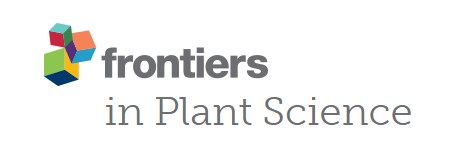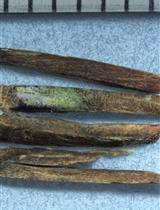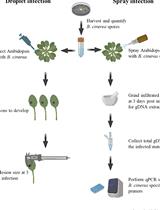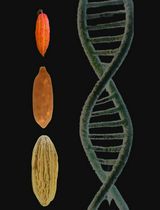- EN - English
- CN - 中文
An Optimized CTAB Method for Genomic DNA Extraction from Freshly-picked Pinnae of Fern, Adiantum capillus-veneris L.
一种从新鲜收取的铁线蕨样品中提取基因组DNA 的优化CTAB法
发布: 2018年07月05日第8卷第13期 DOI: 10.21769/BioProtoc.2906 浏览次数: 17799
评审: Anonymous reviewer(s)
Abstract
As the sister clade of seed plants, ferns are significant materials for plant phylogeny research. However, the genomic DNA extraction protocol for fern samples like modified CTAB method still lacks robustness. Here, we found that the amount and condition of the pinnae samples are critical for gDNA extraction in fern, Adiantum capillus-veneris L. In 500 μl CTAB solution, the recommended amount of pinnae is about 10-20 mg (2-3 pieces). The condition of the pinnae must be instantly-picked from a plant cultivated in a suitable environment. With these factors under control, it is highly reproducible to get the high-quality gDNA with low degradation rate
Keywords: Fern (蕨类)Background
The CTAB method has been applied to gDNA extraction from Adiantum capillus-veneris L. (Han et al., 2012; Li et al., 2017). However, the protocol still shows instability and high degradation rate in our experiment. The pinnae of ferns accumulate large quantities of secondary metabolites, such as polysaccharides and polyphenols, which is adverse to DNA extraction (Ponnusamy et al., 2015).
To increase the robustness of gDNA extraction, we optimized the protocol basically from two aspects: 1) Reduce the amount of material and use only 2-3 pinnae (about 10-20 mg). 2) The pinnae must be freshly picked from a plant cultured in suitable cultivation environment (temperature: 25 °C, humidity: 65%, 16-h white light/8-h dark treatment) and instantly used for DNA extraction. Compared with the classical method, we can get gDNA of higher quality and lower degradation rate from ferns with this optimized protocol.
Materials and Reagents
- 1.5 ml Eppendorf tubes (Eppendorf®)
- Steel beads (Diameter: 3.175 mm)
- Nutrient soil
- Vermiculite
- Pipette tips (Corning, Axygen®, catalog number: T-1000-B ; T-200-Y ; T-300 )
- Freshly-picked pinnae of Adiantum capillus-veneris
Note: The plant is cultured in the cultivation room of PKU for several years and generations, which makes it domesticated. - Liquid nitrogen
- β-mercapto-ethanol (BME) (Thermo Fisher Scientific, Gibco®, catalog number: 21985023 )
- PVP-40 (AMRESCO, catalog number: 0507-500G )
- Phenol:Chloroform:Isoamyl alcohol (25:24:1) (Coolaber, catalog number: SL2040-100ML ) (purity: AR)
- Chloroform, purity: AR
- Isopropanol, purity: AR
- 75% ethanol, purity: AR
- Ultrapure water
- CTAB (AMRESCO, catalog number: 0833-1KG )
- Sodium chloride, purity: GR
- EDTA (AMRESCO, catalog number: 0322 )
- Tris (AMRESCO, catalog number: 0497-5KG )
- RNase I
- HCl, purity: AR
- M3 (Marker III) (TIANGEN Biotech, catalog number: MD103 )
- 2% CTAB (see Recipes)
- 10% RNaseI (TaKaRa, catalog number: 2158-1 ) (see Recipes)
Equipment
- Pipettes (Eppendorf®)
- Stainless steel spoon
- Mortar (diameter: 100 mm) and pestle (size: 117 mm)
- Tissue grinder (Retsch®, TissueLyser II)
- Water bath (65 °C)
- High-speed centrifuges (Refrigeration is not necessary)
- Refrigerator (-20 °C)
- Oven (37 °C)
- Magnetic stirrer
- Electrophoresis equipment
Procedure
文章信息
版权信息
© 2018 The Authors; exclusive licensee Bio-protocol LLC.
如何引用
Yi, S., Jin, W., Yuan, Y. and Fang, Y. (2018). An Optimized CTAB Method for Genomic DNA Extraction from Freshly-picked Pinnae of Fern, Adiantum capillus-veneris L.. Bio-protocol 8(13): e2906. DOI: 10.21769/BioProtoc.2906.
分类
植物科学 > 植物分子生物学 > DNA > DNA 提取
分子生物学 > DNA > DNA 提取
您对这篇实验方法有问题吗?
在此处发布您的问题,我们将邀请本文作者来回答。同时,我们会将您的问题发布到Bio-protocol Exchange,以便寻求社区成员的帮助。
提问指南
+ 问题描述
写下详细的问题描述,包括所有有助于他人回答您问题的信息(例如实验过程、条件和相关图像等)。
Share
Bluesky
X
Copy link












